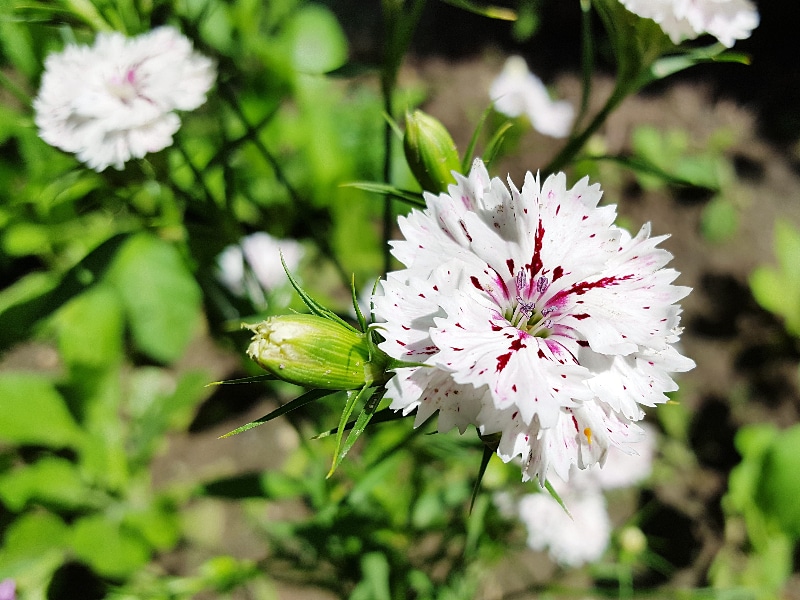You have three options if you’re interested in learning how to propagate dianthus. This gorgeous flowering plant offers many varieties, including annuals, biennials, and perennials of different colors. And because you have three methods to propagate dianthus, every gardener can choose what they think is convenient for their circumstances.
Dianthus is relatively easy to propagate and grow that they will even thrive well in pots. However, it’s worth noting that propagation means you’re starting from young plants, so their starting environment should be stable and optimal. Whether you’re sowing seeds or planting cuttings and division, consider rooting dianthus in the greenhouse until your outdoor environment is stable.

How To Propagate Dianthus Comprehensive Guide
Option #1. Seeds
Dianthus have capsule-like fruits, and you can collect them for seeds, but be careful in handling them because they get damaged easily. You can store the seeds in a sealed container that blocks light and then place it somewhere cool and dark.
Sowing dianthus seeds is relatively safe and straightforward, especially when you start indoors at six weeks before frost. Fill a starter tray with a mix of potting soil, peat moss, compost, and sand. Make sure that this medium is moist and cover the seeds lightly after sowing.
Place the trays somewhere bright but out of direct sunlight, and dianthus should germinate after ten days or less. However, they must be away from drafts and other extreme conditions. You can then transplant the seedlings when they reach around 4 inches in height.
Option #2. Cuttings
Propagating dianthus from either cuttings or divisions is a sure way to create clones of your favorite plants. You can ensure that the young plants will be right to your parent plant’s characteristics, unlike seeds. However, make sure that the parent plant you’ll use is healthy so that it won’t get stressed after you take cuttings.
When is the best time to take dianthus cuttings? The best time to do so is on a cloudy day sometime in June or July after the plants finished flowering. You can also prepare your parent plant by watering it well before you plan on taking a cutting.
Select a healthy cutting with leaf nodes and dip its end in a rooting hormone powder. You can use a starter pot with a mix of vermiculite and sand, then make sure that the stem is well-supported after you inserted it. Maintain moisture and cover with plastic, then place it somewhere bright until transplanting when it grows new leaves.
Option #3. Division
The final propagation method for dianthus is from division, and this is best for the perennial varieties of the plant. More so, the division is also part of maintenance as your dianthus plant matures, and you can do this in early spring while it’s actively growing. You can divide a mature plant every three years, which is an excellent way to produce more plants from a variety you love.
To divide dianthus:
- Dig around the plant so you can lift the root ball comfortably without damaging it
- Remove the soil around the roots to make sectioning easier, and you should get around three pieces of section
- Throw away the dead portions and make sure to transplant the sections as soon as possible
For planting, use the same depth of where they are growing as measurement and support each division by pressing the soil around its roots. Much like with seeds and cuttings, you want to maintain moisture for the plant’s establishment. To prevent the divisions from drying, prepare the medium beforehand using moist potting soil or the same material it’s from if you’re planting in the garden.
Caring For Dianthus
After propagation, you should also learn how to care for dianthus to ensure that they stay healthy and resilient against environmental challenges. In general, they are not meticulous when it comes to location. This is why after establishment, you can select an area with fertile and well-draining soil either under full sun or partial shade.
Perhaps the most common mistake when caring for dianthus is overwatering. Much like other flowering plants, it’s best to only water dianthus when the medium is dry. You can also feed them every six weeks or use a slow-release fertilizer according to the label.
Nonetheless, it would be best to know the specific needs of the dianthus variety you have. For example, some dianthus plants require deadheading because they are self-sowing. On the other hand, some types may not require additional maintenance practices.
Conclusion
Dianthus is one of the most diverse flowering plants that you can get for the garden. Therefore, knowing how to propagate dianthus will give you the flexibility to create more of this gorgeous plant, regardless of the variety you have. You’ll be pleased to know that dianthus can root either from roots, cuttings, and division, so you have more options to choose from.
With seeds, you can avoid the challenges of the climate by sowing indoors. You don’t need to do any pre-germination treatment, and dianthus should root within a week. On the other hand, using cuttings or division is a useful method for those with existing adult plants.
With a healthy dianthus parent plant, you can take cuttings and root them directly. Those who have dianthus plants around three years old can also take sections and grow new plants. In general, dianthus doesn’t have many requirements to establish itself as long as you start in an ideal environment like the greenhouse before transplanting.
